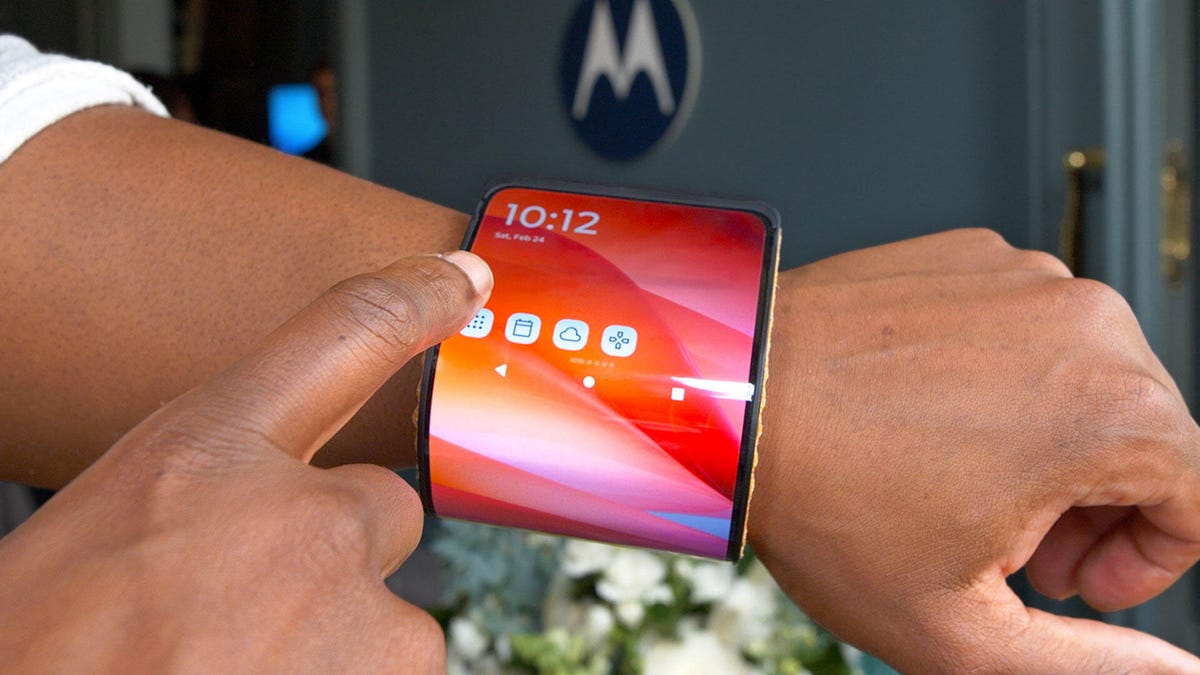At MWC 2024, the Future of Display Tech Is Clear (and Bendy)
Companies like Samsung, Motorola and Lenovo flex their imagination with concepts that'll change how we use our devices -- if they ever see the light of day.

The future, according to Motorola.
Today's phones and laptops are undoubtedly more powerful and capable than they've ever been, but they're also quite... boring. Apart from minor tweaks here and there -- smaller bezels one year, bigger camera bumps the next -- each product release cycle has become somewhat predictable.
Which is why companies are scrambling to find that latest, jaw-dropping tech innovation that captures our collective attention and intrigue, using tech shows like Mobile World Congress as a platform to tout what they see as the future of our favorite gadgets. Ever wanted a phone that bends around your wrist? Or a see-through laptop? No? Well, brands like Samsung, Motorola and Lenovo want you to think again.
See also: MWC 2024: Top Exhibits, Product Launches, and Trends
Several exhibits at this year's show demonstrate future display concepts, like the Samsung Cling Band, a combination phone-smartwatch-fitness tracker that curves around your wrist, like some mega-futuristic slap bracelet. Why, exactly, would you want this? Well, smartwatches have gotten smarter in recent years, but oftentimes you're still limited by a miniscule display. (I mean, have you tried typing on a smartwatch?) Imagine the entire device being a touchscreen, where you can scroll through photos, browse Instagram and compose a message without losing your patience.
Samsung's Cling Band is part phone, part smartwatch, part fitness tracker.
Samsung's Cling Band is still very much a rough concept, according to CNET's Katie Collins, who demoed it at MWC and struggled to do more than some basic scrolling without the screen acting up.
For a more developed ideation, there's Motorola's "adaptive display concept," which was first teased last year but was available at the trade show for CNET's Andrew Lanxon to get his wrists on.
Motorola's device looks and works like any other Android phone when it's flat. But when you're ready to pack it up, just bend the device around your wrist and it'll stay in place, thanks to a magnetic strap. Then it'll serve as more of a smartwatch, showing you notifications and allowing you to still scroll through your apps.
But as is the case for any successful technology, there needs to be a clear use case. Do I really need my phone to also be a watch? Will I want to put something that bulky around my wrist instead of just in my pocket? Companies like Samsung and Motorola are surely seeking answers as they continue to develop these concepts, and what they find will help determine whether they ever see the light of day.
It's not just mobile concepts stealing the show at MWC this year. Lenovo has looked into its crystal ball and the future is clear -- quite literally, as it's touting a laptop concept with a fully transparent screen. The 17.3-inch micro-LED display is like a see-through whiteboard, letting you overlay the real world with whatever you conjure up on your laptop. And instead of physical keys (because that would just kill the vibe), there's a transparent keyboard, which can also function as a drawing board and be used with a supported pen.
But what if I don't want everyone to see what I'm doing on my laptop? Lenovo says transmittance will be adjustable in the future, so you can tweak transparency and shield any private info. But could I use this outdoors in bright sunlight? You should be able to, thanks to 1,000-nit brightness. OK, so when can I have it? Who knows! It's still an early concept.
Oppo also used MWC to debut the Air Glass 3, its latest smart glasses prototype. These glasses can interact with Oppo's AI assistant and are compatible with Oppo phones running ColorOS 13 or later. In keeping with the theme of the previous concepts, we don't know when the Air Glass 3 will be available to purchase.
But in this latest iteration, Oppo says it's developed a new resin waveguide to reduce the "rainbow effect," which is when light refracts as it passes through the lenses. Waveguides are what beam virtual images to the eye, lending to the "smart" aspect of smart glasses. Touch sensors on the side help with navigating, and Oppo says you can use the glasses to look at pictures, make calls and play music, for instance. Other features like viewing health information and language translation should be added in the future.
In recent years, it's become somewhat predictable to see bendy, rollable and transparent displays that reshape how we see the future of tech, as companies look for ways to innovate and stand out. At CES this year, we saw LG's transparent OLED TV and Samsung's micro-LED transparent displays, and at last year's MWC, Motorola showed off a phone with a rollable screen. While these concepts paint an exciting picture for what could be next in the world of tech and innovation, we're probably a long ways away from seeing them out in the real world.
But that doesn't mean at least some won't eventually come to fruition. There was once a time when foldable smartphones sounded like a far-off dream, but they're now a notable player in the industry. Or take LG's rollable TV, which was an astonishing revelation several years ago but which you can now own, for the low cost of $100,000 (meaning you actually probably can't own it, but alas). All that to say, with some patience -- and deep pockets -- anything's possible.

